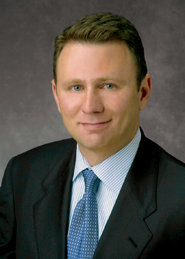Transaction-cost analysis is in the process of evolving into a set of powerful tools providing real-time information and decision support capabilities that are expected to give traders a leg up to find the most liquidity at the best price.
Long gone are the days when transaction-cost analysis involved sorting through reams of Excel spreadsheets. Despite its current shortcomings, TCA has matured as a tool recently and now helps shave execution costs for firms that have looked to better understand their trading process.
“What you are looking for is information that helps you understand the impact of certain factors on trading costs, such as the trading methodology, unique portfolio manager behaviors or the performance of broker-dealers across sectors, to name a few,” explained Brian Fagen, Deutsche Bank’s head of sales for North American execution services.

Still, there is a wide gulf between the money management firms at the top of the food chain that are enhancing their trading performance with TCA and those further down the continuum that are simply using it to fulfill a compliance obligation for boards of directors. That gap between the two could narrow soon, however.
A few large money managers, as well as quant-oriented firms such as Batterymarch Financial Management, have built customized systems that provide traders with a trading strategy, plus the best brokers or algos to choose from for a particular stock. Now off-the-shelf solutions that provide similar capabilities are coming to market.
Decision Support
ITG has just rolled out a decision support tool that suggests specific algorithms or brokers at the point of trade. Markit, which recently acquired QSG, has a product that allows traders to determine the best broker algo for a particular order based on past experience in a very similar trading scenario or situation.
Meanwhile, both vendors are planning to roll out real-time pre-trade systems in the first half of this year based on entirely new methodologies.
TCA vendors currently provide pre-trade cost estimates, but they are based on data from up to the day before. The new pre-trade systems being developed by ITG and Markit will deliver cost estimates based on information that includes trade data from the same day. A few buyside firms have this capability now, and observers say that in addition to ITG and Markit, this type of service is likely to be developed by EMS providers working with TCA vendors that have the expertise to build an analytic model.
As recently as two or three years ago, TCA “was seen as an exercise that led to a step change in trading behavior or as part of a periodic review with a broker or stakeholder,” said Mike Googe, global head of Bloomberg’s TCA product. Now, he said, the focus is on making TCA outputs actionable and linked to quality data, so the product can provide decision support.
“In the future, TCA is likely to play a role automating the trade execution process,” Googe said. “For example, TCA can help determine ‘steady-state’ orders for automated routing, allowing traders to focus their efforts and add value on tougher trades.”
Said Ian Domowitz, managing director and CEO of ITG Solutions Network: “Clients are asking for actionable information at the point of trade, as opposed to having to look up, whether it’s online or in a book, the results of post-trade.”
ITG has just launched a new decision support tool, called Smart Destination Analyzer, that does just that. The solution takes real-time information off the blotter, such as volatility at a specific point in time and the order’s percentage of daily volume, and goes back to a performance database to see how trades with those characteristics performed over the last six months.

“To me, the next step is taking the information from these performance databases that gets built up via post-trade TCA. We collect, for example, hundreds of millions of rows of data,” Domowitz said. “So if you ask the question, ‘What would it be like to trade 100,000 shares of Vodafone, to buy right now?’ you actually do have information, such as how different brokers handle such an order, what the expectation in terms of cost would be for that order, what type of algorithm might be best to trade that type of order. To do that, you need to reach back to historical data and actually pull out that information, play it on the screen in real time.
“That is what I believe is the new frontier: truly actionable information at the point of trade using real performance data, as opposed to just market data,” he said.
Markit offers a similar service called the Pretrade Strategy Workbench. The product enables users to seamlessly integrate historical trading activity with a pre-trade list, so they can determine the most suitable broker algorithm for each order. The product allows clients to upload pre-trade lists to a Web-based platform and has also been integrated with certain EMSs, allowing for a direct response of analytics to orders on the blotter. Traders can select historical market circumstances that replicate the current trading day, so they can determine the best broker algorithm to use for a given benchmark. The characteristics that traders can filter for include: trade volatility, trade momentum, capitalization, order size, sector, side and any other custom fields flagged in the client’s post-trade data.
Currently in development, ITG’s new pre-trade service is different from solutions that produce a single cost for the order, Domowitz said. ITG’s service will produce a whole sequence of cost estimates for the order depending upon the stage of the order and market conditions. The system will also recommend how much to trade at any particular point in time.
For instance, a trader may start thinking about a trade at 10 a.m., when certain market conditions prevail. The model would take those into account and forecast what the strategy might be and what the cost would be. Then at 10:15, when the trader has done part of the order, the order size will be different and market conditions may have changed. So the trader can get another prediction. The system may recommend that the rest of the order be traded with a different strategy and provide an expected cost.
“So you can get a whole sequence of these cost estimates as you trade through the order,” Domowitz said. “That type of adaptive strategy selection and cost forecasting is new, to the best of my knowledge.”
Price Impact
Markit’s system is also based on new pre-trade methodology and includes a real-time cost and analysis component. Using a technique that reconciles all client executions to the market trade and quote data, the service is the first to separate out the price impact the trader is having on the stock versus the short-term market drift, said Alex Hagmeyer, a vice president of data analytics and research at Markit. “Traders have always wanted to understand what kind of price impact they’re putting on the stock. Our calculation allows them to understand that empirically,” he said.

Markit’s system compares a proprietary metric called the cumulative liquidity charge, which is the trader’s actual impact on the stock when he or she is trading it, with the pre-trade forecast. If the cumulative liquidity charge hits a certain threshold on the order being traded, the trader or algorithm gets an alert. “There’s a 90/10 rule-90 percent of the costs come from 10 percent or less of the trades,” Hagmeyer said. “One of our goals is to help traders on those 10 percent really tough-to-trade orders.”
Markit currently offers the service on a T+1 basis, but is planning to apply the same processing logic in a real-time setting, sometime in the second quarter of this year. The real-time system “will grab the trade that you’re doing and compare it to what is actually happening in the market and provide a running total as the day is progressing, so you will have an idea of what impact you’re having intraday, rather than waiting until the next day,” said George Bodine, a vice president and consultant at Markit.
Markit is also working with an independent algorithm developer on implementing the real-time cumulative liquidity charge logic into a dark liquidity-seeking algorithm that can be used by traders to more effectively manage their price impact.
According to a Greenwich Associates report last August, about 68 percent of the 142 equity investors surveyed used TCA as part of their investment process. The figure is 77 percent for firms with more than $20 billion under management.
The survey outlined concerns about TCA, namely the accuracy of the data used to make the calculations, which requires firms that do their own TCA to “scrub the data” to ensure its accuracy. The other concern is whether TCA gives traders and firms so-called actionable information to make them better investors for their clients.
One statistic in the report showed that 10 percent of those surveyed had “staff exclusively dedicated to TCA.” To be sure, firms have varying abilities to pay attention to TCA and sometimes for different reasons.
Observers put the buyside consumers of TCA into three categories. The first group is composed of firms-mostly smaller shops-that use a third-party vendor only. This gives them the basics, such as peer analysis and the reporting that boards of directors need to review trading and related issues.
Managers in the second group take trading costs more seriously and do their trade-cost analysis in-house. They typically also use the vendor solution for reporting purposes, as well. The in-house TCA allows a firm to get deeper into trades and to review the nuances of each one, asking the question: “How can I improve?”
The final category is the crème de la crème of managers, who are doing their own TCA in real time and are able to adjust strategy on the fly-which, according to Deutsche Bank’s Fagen, is “the next frontier.”
“There are a few firms that have the scale and have made the investment, and they’ve made it a very important part of their process and have spent time, money and effort on it,” Fagen said.
Batterymarch Financial Management is one such firm. It was featured in Traders Magazine in June 2011.
Batterymarch’s decision support platform captures historic data from a variety of internal and external sources and profiles trades on a number of characteristics. The platform measures liquidity, volatility, trend and momentum. The system then provides an execution strategy for the trader, based on a portfolio manager’s urgency and the expected level of alpha-as well as the historical data. Each strategy offers a subset of execution options to the trader: The trader can choose from a menu of upstairs desks or algorithms. But every decision-and data point-along the way is captured. The system uses FlexTrade as its front end.
Money managers building customized systems can do things that vendor-provided systems can’t, because they can include proprietary information that firms would never share with a vendor, such as what the portfolio manager’s alpha model is. When firms build their own systems, they can evaluate the trade’s cost and its contribution to net alpha.
Dragan Skoko, director of trading at Batterymarch Financial, is one of about a handful or so of money managers who does in-house TCA in real time and allows traders to adjust their strategy. He says he can understand why a firm, particularly a smaller one, would not want to make the investment. “There’s no doubt that there is value in it,” Skoko said. “It’s just a matter of making a business decision and tackling it or not.”
Skoko says he can see the benefit of vendor-provided systems to the buyside: “They can certainly help you to decide which execution strategy to use and to evaluate the quality of the different algo offerings of brokers.”
Other firms use a mix of vendor-supplied offerings and internally developed systems. ING Investment Management uses both a proprietary TCA system and vendor offerings because “not every off-the-shelf offering is as customized as it could be,” said Nanette Buziak, ING’s head of equity trading. “TCA has not only helped us in improving our execution quality and ability to add alpha, but it has also demonstrated the value my team adds.”
Granular Data
With the rise of electronic trading, firms need to measure the performance of algorithms. And because order sizes and fills are smaller, analysis needs to occur on a micro level.

“When TCA first started, people didn’t even have time stamps on their orders,” said Matt Celebuski, a senior managing director who heads quantitative analytics and trading at SJ Levinson. Celebuski was previously a senior managing director and product manager for Bear Stearns electronic trading group. Without time stamps, a trader wouldn’t know the interval value-weighted average price during the exact time he or she was trading.
“TCA 10 years ago looked at a trade versus some very broad benchmarks. They may have had an expected cost, and they may have been looking at the VWAP over the day. It’s very hard to improve when those are the two things you’re looking at,” Celebuski said.
“Now, with the advent of electronic time stamps, highly accurate tick data and a lot of high-end, quantitative research, we’re able to combine that information and give you the score for each question, so the trader can improve. Where did they fall shy or did they excel?” he said.
At Bear Stearns, Celebuski’s group “saved every single piece of information as to why we did something and then looked at the results of those decisions,” he said. “You continually use that feedback to get better. So by hyper-measuring all of the decisions, you can then see which ones did well and which ones did poorly. Essentially, we’d just hone it and repeat the ones we did well. In a simplistic sense, that’s what we’re doing now at SJ Levinson.”
Indeed, focusing on building their electronic trading businesses, brokers are investing in this type of analysis. They are looking to analyze the effectiveness of trading strategies based on data from the order book or the ratio of trade messages to quote messages, observers say. The one drawback to broker TCA solutions, however, is that brokers can only measure and analyze the executions and algo strategies that they offer and cannot go across brokers.
Bank of America Merrill Lynch’s focus is on providing customized TCA reports to provide clients with the color they need. Said Kevin Tyrrell, a vice president of execution consulting at Bank of America Merrill Lynch: “One thing we’ve done a lot recently is try to put the order flow into context for the client. When we measure any kind of performance by trading strategy, we can include other concurrent situations, so we’ll say, ‘This is how the strategy performed for you, this is what happened to the stock during the time you were trading it, and also what was going on in the market or that sector,’ so the client knows what the overall macro picture looked like.”
“More than anything, what we’re going to see in terms of TCA is continued customization for clients,” said Oliver Sung, who runs the equity execution consulting group at Bank of America Merrill Lynch. “Really knowing what the client is doing and customizing TCA for them, so you don’t have a one-size-fits-all approach.”
– Michael Scotti, editorial director, contributed to this article.
(c) 2012 Traders Magazine and SourceMedia, Inc. All Rights Reserved.
http://www.tradersmagazine.com http://www.sourcemedia.com/



